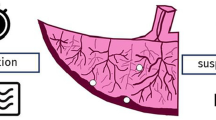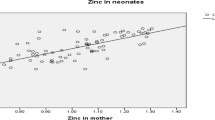Abstract
Adolescence is marked by intensive growth and development. When pregnancy occurs during this period of the mother’s growth, there is an increase in her nutritional needs. The aim of this study was to determine the levels of calcium, iron, copper, and zinc in maternal plasma, the placenta, and in the cord plasma of pregnant teenagers and adults. A total of 80 sets of maternal plasma, placentas, and cord plasma (40 from teenagers and 40 from adults) were analyzed using synchrotron radiation total reflection X-ray fluorescence. The levels of calcium, copper, and zinc in the maternal and cord plasma from teenagers were not significantly different than those from adults. Iron levels in the teenagers maternal and cord plasma were higher than in the adults. All of the minerals analyzed were present at higher levels in the placentas from adults than those from teenagers. However, the low quantities of placental calcium, iron, copper, and zinc in the teenagers do not compromise the levels of these minerals in the cord plasma. Future research regarding the placental transport of these minerals is recommended to investigate the efficiency of mechanisms of transfer of these minerals in pregnant teenagers.




Similar content being viewed by others
References
American Dietetic Association (1989) Nutrition management of adolescent. J Am Diet Assoc 89:104–109
Naeye RL (1981) Teenaged and pre-teenaged pregnancies: consequences of the fetal-maternal competition for nutrients. Pediatrics 67:146–150
Ashworth CJ, Antipatis C (2001) Micronutrient programming of development throughout gestation. Reproduction 122:527–535
Storey LM, Forshee RA, Anderson PA (2004) Associations of adequate intake of calcium with diet, beverage consumption, and demographic characteristics among children and adolescents. JACN 23(1):18–33
Vaskonen T (2003) Dietary minerals and modification of cardiovascular disease risk factors. J Nutr Biochem 14(9):492–506
De Maeyer EM, Adiéls-Tegman M (1985) The prevalence of anaemia in the world. World Health Stat Q 38:302–316
Prohaska JR, Lukasewycz OA (1990) Effects of copper deficiency on the immune system. Adv Exp Med Biol 262:123–144
Black RE (2001) Micronutrients in pregnancy. Brit J Nutr 85(suppl):193S–197S
Hyvonen-Dabek M, Nikkinen-Vilkki P, Dabeck JT (1984) Selenium and other elements in human maternal and umbilical serum, as determined simultaneously by proton-induced X-Ray emission. Clin Chem 30(4):529–533
Beard JL (1994) Iron deficiency: assessment during pregnancy and its importance in pregnant adolescents. Am J Clin Nutr 59(suppl):502S–510S
Gambling L, Danzeisen R, Fosset C, Andersen HS, Dunford S, Srai SKS, Mcardle HJ (2003) Iron and copper interactions in development and the effect on pregnancy outcome. J Nutr 133(suppl):1554S–1556S
Capurro H (1978) A simplified method for diagnosis of gestational age in the newborn infant. J Pediatr 93:120–122
Ballard JL, Khoury JC, Wedig K, Wang L, Eilers-Walsman BL, Lipp R (1991) New Ballard score, expanded to include extremely premature infants. J Pediatr 119(3):417–423
World Health Organization (1995) Physical status: the use and interpretation of anthropometry. Technical Report Series 854. WHO, Geneva
World Health Organization (2007) Development of a WHO growth reference for school-aged children and adolescents. Bull World Health Organ 85:660–667
Institute of Medicine (1990) National Academy of Sciences. Nutrition during pregnancy and lactation. National Academy Press, Washington
Institute of Medicine (1992) National Academy of Sciences. Nutrition during pregnancy and lactation. An implementation guide. National Academy Press, Washington
Schauberger CW, Pitkin RM (1979) Maternal-perinatal calcium relationships. Obstet Gynecol 53:74–76
Pitkin RM (1985) Calcium metabolism in pregnancy and the perinatal period: a review. Am J Obstet Gynecol 151:99–109
Raghunath R, Tripathi RM, Sastry VN, Krishnamoorthy TM (2000) Heavy metals in maternal and cord blood. Sci Total Environ 250:135–141
Iyengar GV, Rapp A (2001) Human placenta as a ‘dual’ biomarker for monitoring fetal and maternal environment with special reference to potentially toxic trace elements. Part 2: essential minor, trace and other non-essential elements in human placenta. Science Total Environ 280:207–219
Anderson JJB (2002) Minerais. In: Mahan LK, Escott-Stump S (eds) Alimentos, nutrição e dietoterapia, vol 11. Editora Roca, São Paulo, pp 106–143
McArdle HJ, Ashworth CJ (1999) Micronutrients in fetal growth and development. Br Med Bull 55:499–510
Krachler M, Rossipal E, Micetic-Turk D (1999) Trace element transfer from the mother to the newborn-investigations on triplets of colostrum, maternal and umbilical cord sera. Eur J Clin Nutr 53(6):486–494
Rossipal E (2000) Investigation on the transport of trace elements across barriers in humans: studies of placental and mammary transfer. J Trace Microprobe Tech 18(4):493–497
Scholl TO, Hediger ML, Scoll JI, Fischer RL, Khoo CS (1993) Low zinc intake during pregnancy: its association with preterm and very preterm delivery. Am J Epidemiol 137:115–124
Helston RM, Phillips SR, McKay JA, Jackson KA, Mathers JC, Ford D (2007) Zinc transporters in the mouse placenta show a coordinated regulatory response to changes in dietary zinc intake. Placenta 28:437–444
Álvarez SI, Castañón SG, Ruata MLC, Aragués EF, Terraz PB, Irazabal YG, González EG, Rodríguez BG (2007) Updating of normal levels of copper, zinc and selenium in serum of pregnant women. J Trace Elem Med Biol 21(S1):49S–52S
Author information
Authors and Affiliations
Corresponding author
Rights and permissions
About this article
Cite this article
de Moraes, M.L., de Faria Barbosa, R., Santo, R.E. et al. Maternal-Fetal Distribution of Calcium, Iron, Copper, and Zinc in Pregnant Teenagers and Adults. Biol Trace Elem Res 139, 126–136 (2011). https://doi.org/10.1007/s12011-010-8649-6
Received:
Accepted:
Published:
Issue Date:
DOI: https://doi.org/10.1007/s12011-010-8649-6




